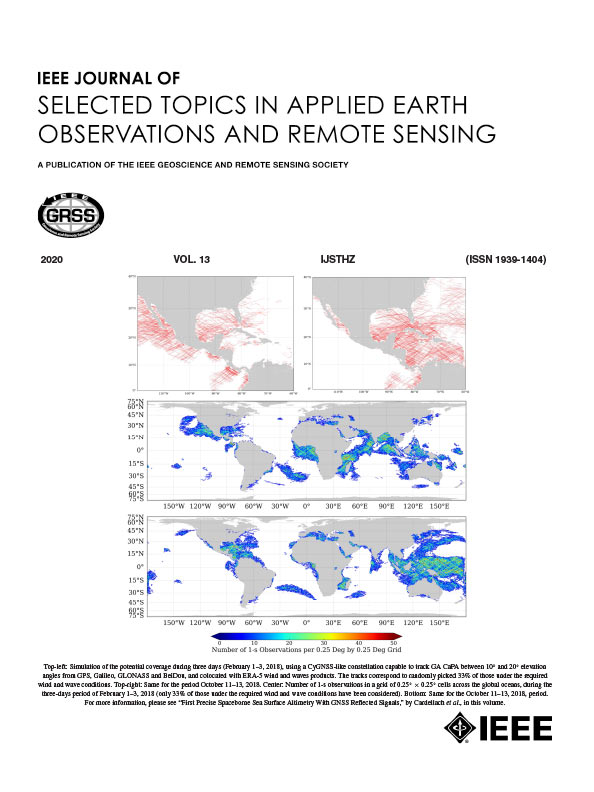FlexShip:一种更灵活的舰船小目标检测网络
IF 5.3
2区 地球科学
Q1 ENGINEERING, ELECTRICAL & ELECTRONIC
IEEE Journal of Selected Topics in Applied Earth Observations and Remote Sensing
Pub Date : 2025-09-25
DOI:10.1109/JSTARS.2025.3614583
引用次数: 0
摘要
遥感船舶探测在海上交通管理和海洋资源监测等领域具有重要意义。尽管最新的舰船目标检测模型已经显示出优异的效果,但它们仍然面临着许多挑战。本文总结了船舶目标检测仍然面临的三大挑战:1)由于遥感图像分辨率的限制和船舶体积小,目标在图像中边缘较弱,难以准确识别;2)海面环境多变,常伴有涟漪、云、尾流等干扰信息,容易造成误检和漏检。3)船舶的长宽比差异很大,方向也不同。传统的矩形帧难以精确包络目标,造成定位不准确和背景冗余。针对上述问题,本文提出了一种名为FlexShip的新方法。具体而言,首先将自校正卷积机制应用于遥感图像目标检测。该网络通过动态卷积核参数标定自适应修改不同尺度和对比区域的特征响应强度,增强了弱船边结构的表达能力。其次,作为特征增强方法的基本要素,我们还创建了特征引导关注模块,引导网络关注船舶区域的关键纹理和轮廓数据。最后,利用极坐标移动预测框。与直角坐标系相比,极坐标系具有更多可调的旋转角度和更少的参数。在多个公共数据集上的大量实验表明,FlexShip在船舶目标检测方面达到了最先进的性能。本文章由计算机程序翻译,如有差异,请以英文原文为准。
FlexShip: A More Flexible Network for Small Target Detection on Marine Ships
Remote sensing ship detection is of great significance to the fields of maritime traffic management and marine resource monitoring. Although the latest ship target detection models have shown excellent results, they still face many challenges. We summarize the three key challenges that ship target detection still faces: 1) Due to the resolution limitation of remote sensing images and the small size of ships, the targets show weak edges in the images and are difficult to accurately identify. 2) The sea surface environment is changeable, often accompanied by interference information such as ripples, clouds, and wake waves, which can easily cause false detection and missed detection. 3) The length-width ratio of ships is very different, and the directions are different. Conventional rectangular frames are difficult to accurately envelop targets, resulting in inaccurate positioning and background redundancy. To address the abovementioned problems, this article proposes a new method called FlexShip. Specifically, first, the self-correcting convolution mechanism is applied to remote sensing image target detection. The network adaptively modifies the feature response strength of different scales and contrast regions through dynamic convolution kernel parameter calibration, enhancing the expression ability of weak ship edge structures. Second, as a basic element of the feature enhancement method, we also create a feature-guided attention module to guide the network to focus on the key texture and contour data of the ship area. Finally, polar coordinates are used to move the prediction box. Compared with the rectangular coordinate system, the polar coordinate system has more adjustable rotation angles and fewer parameters. Extensive experiments on multiple public datasets show that the proposed FlexShip achieves state-of-the-art performance in ship target detection.
求助全文
通过发布文献求助,成功后即可免费获取论文全文。
去求助
来源期刊
CiteScore
9.30
自引率
10.90%
发文量
563
审稿时长
4.7 months
期刊介绍:
The IEEE Journal of Selected Topics in Applied Earth Observations and Remote Sensing addresses the growing field of applications in Earth observations and remote sensing, and also provides a venue for the rapidly expanding special issues that are being sponsored by the IEEE Geosciences and Remote Sensing Society. The journal draws upon the experience of the highly successful “IEEE Transactions on Geoscience and Remote Sensing” and provide a complementary medium for the wide range of topics in applied earth observations. The ‘Applications’ areas encompasses the societal benefit areas of the Global Earth Observations Systems of Systems (GEOSS) program. Through deliberations over two years, ministers from 50 countries agreed to identify nine areas where Earth observation could positively impact the quality of life and health of their respective countries. Some of these are areas not traditionally addressed in the IEEE context. These include biodiversity, health and climate. Yet it is the skill sets of IEEE members, in areas such as observations, communications, computers, signal processing, standards and ocean engineering, that form the technical underpinnings of GEOSS. Thus, the Journal attracts a broad range of interests that serves both present members in new ways and expands the IEEE visibility into new areas.

 求助内容:
求助内容: 应助结果提醒方式:
应助结果提醒方式:


